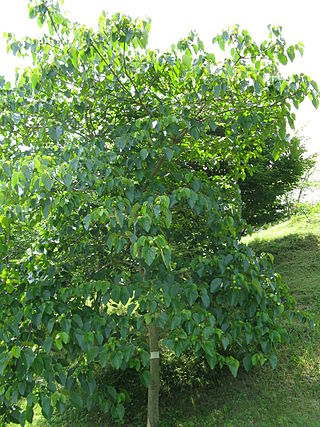
Vernicia fordii is a species of flowering plant in the spurge family Euphorbiaceae. It is native to southern China, Myanmar, and northern Vietnam. It is a small to medium-sized deciduous tree growing to 20 m tall, with a spreading crown. The bark is smooth and thin, and bleeds latex if cut. The leaves are alternate, simple, 4.5–25 cm long and 3.5–22 cm broad, heart-shaped or with three shallow, maple-like lobes, green above and below, red conspicuous glands at the base of the leaf, and with a 5.5–26 cm long petiole. The flowers are 2.5–3.5 cm diameter, with five pale pink to purple petals with streaks of darker red or purple in the throat; it is monoecious with individual flowers either male or female, but produced together in the inflorescences. The flowers appear before or with the leaves in loose, terminal clusters. The fruit is a hard, woody pear-shaped berry 4–6 cm long and 3–5 cm diameter, containing four or five large, oily seeds; it is green initially, becoming dull brown when ripe in autumn.
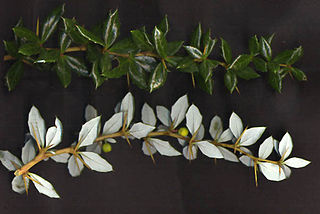
Berberis verruculosa, the warty barberry or warted barberry, is an evergreen shrub in the family Berberidaceae. It ranges in size from 1–2 m, and is native to western China. It gets its common name from its "warty" stems, that have rounded, more or less identical, raised spots.

Staphylea, called bladdernuts, is a small genus of 10 or 11 species of flowering plants in the family Staphyleaceae, native to temperate regions of the Northern Hemisphere. The highest species diversity is in China, where four species occur.

Aristolochia westlandii is a species of plant in the family Aristolochiaceae. It is found in China and Hong Kong, in valley forests in Guangdong Province at an elevation of 300 to 800 metres. The leaves are long, narrow and pointed. The flowers are bent tubes from 10–15 centimetres (3.9–5.9 in) long that grow from the base of a leaf. They are yellow with purple veins and blotches.

Asarum maximum is a species of plant in the family Aristolochiaceae. It is endemic to China. The flowers have a distinct smell of mushrooms.
Phoebe bournei is a species of tree up to 20 metres (66 ft) tall in the family Lauraceae. It is endemic to China, where it occurs in Fujian, Guangdong, Guangxi, Guizhou, Hainan, Hubei, and Jiangxi provinces. It is threatened by habitat loss. The species is under second-class national protection in China.
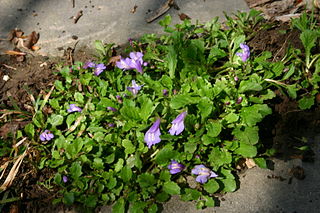
Mazus is a genus of low-growing perennial plants. It has been placed in various plant families including Phrymaceae, Scrophulariaceae, and recently in the family Mazaceae. Consisting of around 40 species, this genus is generally found in damp habitats in lowland or mountain regions of China, Japan, India, Southeast Asia, Australia and New Zealand.
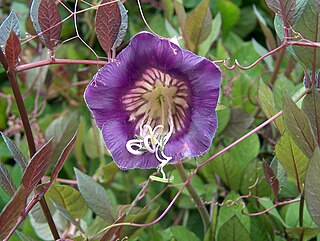
Cobaea is a genus of flowering plants including about 20 species of rapid growing, ornamental climbers whose native range extends from Mexico to Peru. The botanical name honors Father Bernabé Cobo, Spanish Jesuit of the seventeenth century, naturalist, and resident of America for many years. The woody stems can reach 20 ft (6 m). Leaves are alternate lobed with opposite pairs and tendrils. In late summer to early spring, the large, bell-shaped flowers are borne profusely and singly along the stems with bright green, violet, or purple in colors. The plants can become invasive in some areas, and are common weeds in New Zealand.
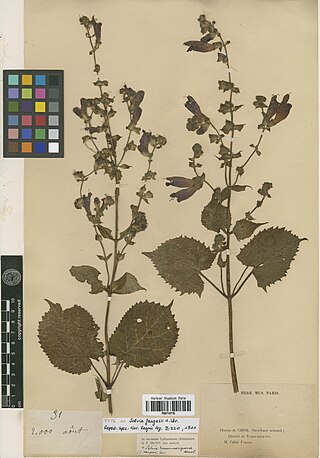
Salvia maximowicziana is a perennial plant in the family Lamiaceae. It is found growing on grasslands, forests, and forest edges in China, at 1,800 to 3,300 m elevation. It grows 10 to 90 cm tall, with circular-cordate to ovate-cordate leaves that are typically 3 to 8 cm long and 6 to 8 cm wide. The upper leaf surface is nearly smooth, or lightly covered with hairs, while the underside has glandular hairs on the veins.

Cornus controversa, syn. Swida controversa, is a species of flowering plant in the dogwood family Cornaceae. It is native to China, Korea, the Himalayas and Japan. It is a deciduous tree growing to 50 ft (15 m), with multiple tiered branches. Flat panicles of white flowers appear in summer, followed by globose black fruit. Ovate dark green leaves are glaucous underneath and turn red-purple in autumn. It is cultivated in gardens and parks in temperate regions.

Rhododendron hancockii (滇南杜鹃) is a species of flowering plant in the family Ericaceae. It is. native to Guangxi and Yunnan, China, where it grows at altitudes of 1,100–2,000 m (3,600–6,600 ft). It is a shrub or tree that grows to 2–7 m (6.6–23.0 ft) in height, with leathery leaves that are obovate or oblong-oblanceolate, 7–13 by 1.5–5 cm in size. The flowers are white with yellowish flecks.

Rhododendron concinnum (秀雅杜鹃) is a species of flowering plant in the family Ericaceae. It is native to Guizhou, Henan, Hubei, Shaanxi, Sichuan, and Yunnan in China, where it grows at altitudes of 2300–3000 meters. It is a shrub that grows to 1.5–3 m in height, with leaves that are oblong, elliptic, ovate, oblong-lanceolate or ovate-lanceolate, 2.5–7.5 by 1.5–3.5 cm in size. Flowers are pale pink to deep purplish red.
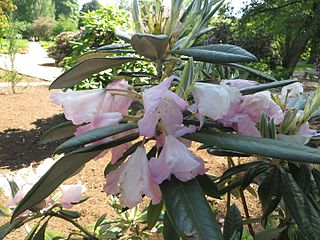
Rhododendron insigne (不凡杜鹃) is a species of flowering plant in the family Ericaceae. It is native to southern Sichuan in China, where it grows at altitudes of 700–2,000 m (2,300–6,600 ft). This evergreen shrub grows to 1.5–6 m (4.9–19.7 ft) in height, with leathery leaves that are obovate-elliptic, obovate-lanceolate, oblong, or oblong-lanceolate, 8–13 by 2.5–4.5 cm in size. The flowers are pale to dark pink.

Rhododendron watsonii (无柄杜鹃) is a species of flowering plant in the family Ericaceae. It is native to southern Gansu and western Sichuan in China, where it grows at altitudes of 2,500–3,000 m (8,200–9,800 ft). It is an evergreen shrub or small tree growing to 1.5–6 m (4.9–19.7 ft) in height, with leathery leaves that are oblong-elliptic to broadly oblanceolate or obovate, 10–33 by 4–10 cm in size. The flowers are white.

Cornus hongkongensis is a species of evergreen dogwood in the family Cornaceae. It is native to China, Laos, and Vietnam. It grows to 15 meters in height and blooms in late spring to early summer, exhibiting an abundance of fragrant flowers. Because this species of dogwood also exhibits a range of minor differences in morphology due largely to geographic distribution, it has been divided into a number of subspecies. It has been described as an excellent ornamental tree species.
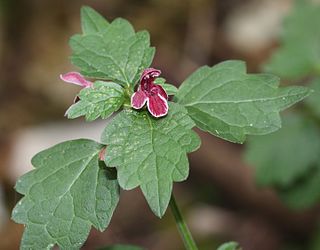
Loxocalyx is a genus of plants in the family Lamiaceae, first described in 1891. It is native to China and Japan.

Lonicera hildebrandiana, the giant Burmese honeysuckle, is a species of flowering plant in the family Caprifoliaceae. It is native to southeast Asia, in China, Thailand and Burma at elevations of 1000 to 2300 meters.
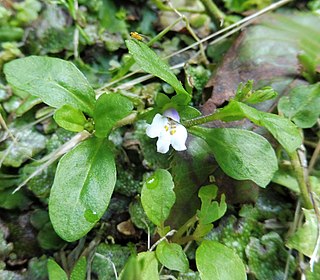
Mazus pumilus, commonly called Japanese mazus, is a species of flowering plant in the Mazaceae family. It is native to south and east Asia, where it is found in Bhutan, China, India, Pakistan, Bangladesh, Indonesia, Japan, Korea, Nepal, New Guinea, the Philippines, Russia, Taiwan, Thailand, and Vietnam. It is an invasive species in North America.

Fraxinus malacophylla is a species of ash tree in the family Oleaceae. It is native to China, where it is found in Guangxi and Yunnan provinces, and Thailand.

Distylium myricoides is a species in the genus Distylium in the family Hamamelidaceae. It is native to southern China.


















